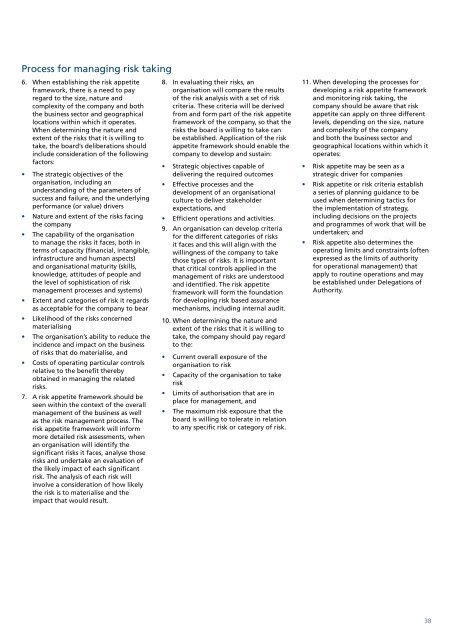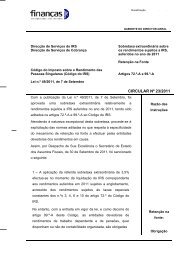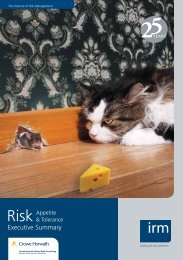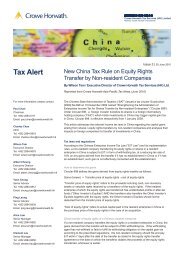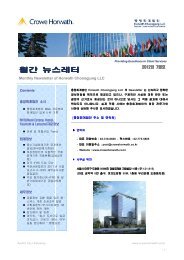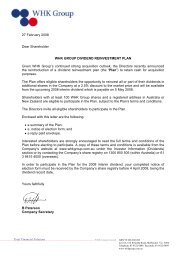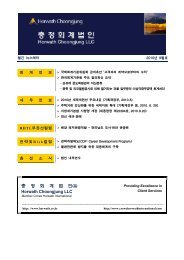Guidance Paper - The Institute of Risk Management
Guidance Paper - The Institute of Risk Management
Guidance Paper - The Institute of Risk Management
Create successful ePaper yourself
Turn your PDF publications into a flip-book with our unique Google optimized e-Paper software.
Process for managing risk taking<br />
6. When establishing the risk appetite<br />
framework, there is a need to pay<br />
regard to the size, nature and<br />
complexity <strong>of</strong> the company and both<br />
the business sector and geographical<br />
locations within which it operates.<br />
When determining the nature and<br />
extent <strong>of</strong> the risks that it is willing to<br />
take, the board’s deliberations should<br />
include consideration <strong>of</strong> the following<br />
factors:<br />
• <strong>The</strong> strategic objectives <strong>of</strong> the<br />
organisation, including an<br />
understanding <strong>of</strong> the parameters <strong>of</strong><br />
success and failure, and the underlying<br />
performance (or value) drivers<br />
• Nature and extent <strong>of</strong> the risks facing<br />
the company<br />
• <strong>The</strong> capability <strong>of</strong> the organisation<br />
to manage the risks it faces, both in<br />
terms <strong>of</strong> capacity (financial, intangible,<br />
infrastructure and human aspects)<br />
and organisational maturity (skills,<br />
knowledge, attitudes <strong>of</strong> people and<br />
the level <strong>of</strong> sophistication <strong>of</strong> risk<br />
management processes and systems)<br />
• Extent and categories <strong>of</strong> risk it regards<br />
as acceptable for the company to bear<br />
• Likelihood <strong>of</strong> the risks concerned<br />
materialising<br />
• <strong>The</strong> organisation’s ability to reduce the<br />
incidence and impact on the business<br />
<strong>of</strong> risks that do materialise, and<br />
• Costs <strong>of</strong> operating particular controls<br />
relative to the benefit thereby<br />
obtained in managing the related<br />
risks.<br />
7. A risk appetite framework should be<br />
seen within the context <strong>of</strong> the overall<br />
management <strong>of</strong> the business as well<br />
as the risk management process. <strong>The</strong><br />
risk appetite framework will inform<br />
more detailed risk assessments, when<br />
an organisation will identify the<br />
significant risks it faces, analyse those<br />
risks and undertake an evaluation <strong>of</strong><br />
the likely impact <strong>of</strong> each significant<br />
risk. <strong>The</strong> analysis <strong>of</strong> each risk will<br />
involve a consideration <strong>of</strong> how likely<br />
the risk is to materialise and the<br />
impact that would result.<br />
8. In evaluating their risks, an<br />
organisation will compare the results<br />
<strong>of</strong> the risk analysis with a set <strong>of</strong> risk<br />
criteria. <strong>The</strong>se criteria will be derived<br />
from and form part <strong>of</strong> the risk appetite<br />
framework <strong>of</strong> the company, so that the<br />
risks the board is willing to take can<br />
be established. Application <strong>of</strong> the risk<br />
appetite framework should enable the<br />
company to develop and sustain:<br />
• Strategic objectives capable <strong>of</strong><br />
delivering the required outcomes<br />
• Effective processes and the<br />
development <strong>of</strong> an organisational<br />
culture to deliver stakeholder<br />
expectations, and<br />
• Efficient operations and activities.<br />
9. An organisation can develop criteria<br />
for the different categories <strong>of</strong> risks<br />
it faces and this will align with the<br />
willingness <strong>of</strong> the company to take<br />
those types <strong>of</strong> risks. It is important<br />
that critical controls applied in the<br />
management <strong>of</strong> risks are understood<br />
and identified. <strong>The</strong> risk appetite<br />
framework will form the foundation<br />
for developing risk based assurance<br />
mechanisms, including internal audit.<br />
10. When determining the nature and<br />
extent <strong>of</strong> the risks that it is willing to<br />
take, the company should pay regard<br />
to the:<br />
• Current overall exposure <strong>of</strong> the<br />
organisation to risk<br />
• Capacity <strong>of</strong> the organisation to take<br />
risk<br />
• Limits <strong>of</strong> authorisation that are in<br />
place for management, and<br />
• <strong>The</strong> maximum risk exposure that the<br />
board is willing to tolerate in relation<br />
to any specific risk or category <strong>of</strong> risk.<br />
11. When developing the processes for<br />
developing a risk appetite framework<br />
and monitoring risk taking, the<br />
company should be aware that risk<br />
appetite can apply on three different<br />
levels, depending on the size, nature<br />
and complexity <strong>of</strong> the company<br />
and both the business sector and<br />
geographical locations within which it<br />
operates:<br />
• <strong>Risk</strong> appetite may be seen as a<br />
strategic driver for companies<br />
• <strong>Risk</strong> appetite or risk criteria establish<br />
a series <strong>of</strong> planning guidance to be<br />
used when determining tactics for<br />
the implementation <strong>of</strong> strategy,<br />
including decisions on the projects<br />
and programmes <strong>of</strong> work that will be<br />
undertaken; and<br />
• <strong>Risk</strong> appetite also determines the<br />
operating limits and constraints (<strong>of</strong>ten<br />
expressed as the limits <strong>of</strong> authority<br />
for operational management) that<br />
apply to routine operations and may<br />
be established under Delegations <strong>of</strong><br />
Authority.<br />
38


